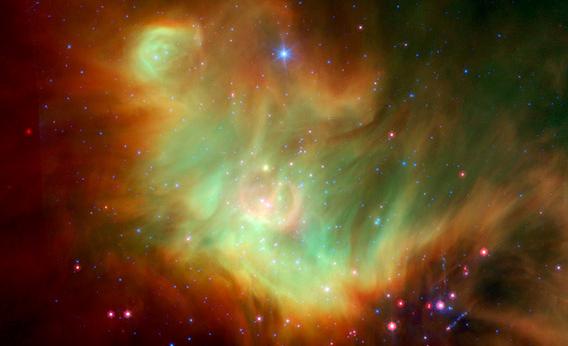Create a free profile to get unlimited access to exclusive videos, sweepstakes, and more!
Protostar Throws a Rave

Iâve been doing this astronomy gig for a while now, and Iâve seen some weird stuff. It takes a lot to surprise me.
The binary star LRLL 54361 surprised me. It is seriously weird and seriously cool.
L54361 (for short) is a pair of stars orbiting each other. They are very young, probably only a hundred thousand years old (the Sun is more than 4 billion, for comparison), and are located near the edge of a gas cloud called IC 348 (seen in the gorgeous infrared Spitzer image above), itself about 950 light years from Earth. Observations taken over seven years show L54361 to be variable, changing in brightness every 25.34 days. The change is huge, too, with the system getting 10 times brighter, then fading over about a week.
Because the system is so young, itâs still surrounded by the dense material from which it formed. In detailed Hubble Space Telescope images (see the sequence below near the bottom of this post) you can see a dark line across the middle of the brightest part of the structure; thatâs a thick opaque disk of dust enveloping the stars and hiding them directly from view. That makes understanding the system a little tricky; we have to infer some things given its behavior.
After eliminating few possibilities, the astronomers studying L54361 came to an interesting conclusion. Clearly, the binary is throwing a rave.
No! Wait! Thatâs not it. Actually, the two stars are probably on very elliptical orbits around each other, passing close to each other every 25.34 days. As they orbit, they drag some of that surrounding material around with them. When they get to their closest approach this material falls onto one or both of the stars and gets incredibly hot. Like a detonation of flash powder, the material gets tremendously bright for a short period of time, sending out a huge and intense pulse of light.
But thereâs more to this story. That light illuminates the surrounding material, reflecting off of it. But that stuff stretches out for a long way. A long way. Hundreds of billions of kilometers, in fact, which means it takes that pulse of light several days to make its way across. So if you observe it over time, you can see the light pulse moving through the material.
Like, say, this:
How flipping awesome is that? This phenomenon is called a light echo, because really thatâs what youâre seeing: an echo made of light instead of sound. And like the way dolphins and bats use echoes to sense their environment, we can learn a lot from watching a light echo, too. The speed it appears to move through the material tells you how big the structure is (though the trigonometry can be a little tricky). You can also tell which side is the front of the material and which is the back, because the light takes longer to hit the material on the far side of the star and then reflect off it to make its way to Earth.
In this case, we can see the echo moving up what looks like a conical shell, like an ice cream cone with its tip near the stars. The interior is dark, so it must be relatively hollow, devoid of gas and dust inside the cone. That is very interesting indeed: It looks like thereâs material falling inward toward the starsâthe stars are still forming, still growingâbut there must have been some outflow, some blow back, that carved out that empty region. It may be in part due to these episodic flashes, or it might be a wind from the young stars, like the solar wind but much stronger.
This sort of periodic episode where stuff falls in, heats up, and flashes intense bursts of light is called pulsed accretion (accretion means to grow by adding material onto something). Itâs been seen a few times, but always with stars much older than this pair, usually ten times older. Clearly, with L54361 this is something unusual. Binary stars on wide elliptical orbits are rare too, plus weâre seeing them when they are very young. Astronomers really hit the lottery here.
Back when I was working on my PhD, I was studying something similar. This time, though, it was at the end of its life. It exploded, setting off a vast and short burst of light that illuminated everything around it. Because of the light echo effect, I was able to figure out a lot about that surrounding material, and researching light echoes was a lot of fun. I found a paper from the 1920s describing it, and then had to rework and rederive all the math to apply it to the object I was studying. It was tough, but solvable, and one of those times when the pure joy of just finding things out swept over me.
And thatâs the reason I love these observations of L54361 so much. Once again, we have something new in the sky to figure out, and we can watch it change right before our eyes on a time scale thatâs palatable to our human sensibilities.
Astronomy is so much fun! And itâs simply wonderful that even after all this time, the Universe can still manage to surprise and delight us.
Tip oâ the glowstick to Charlotte Moore for the idea to call this a rave.


























